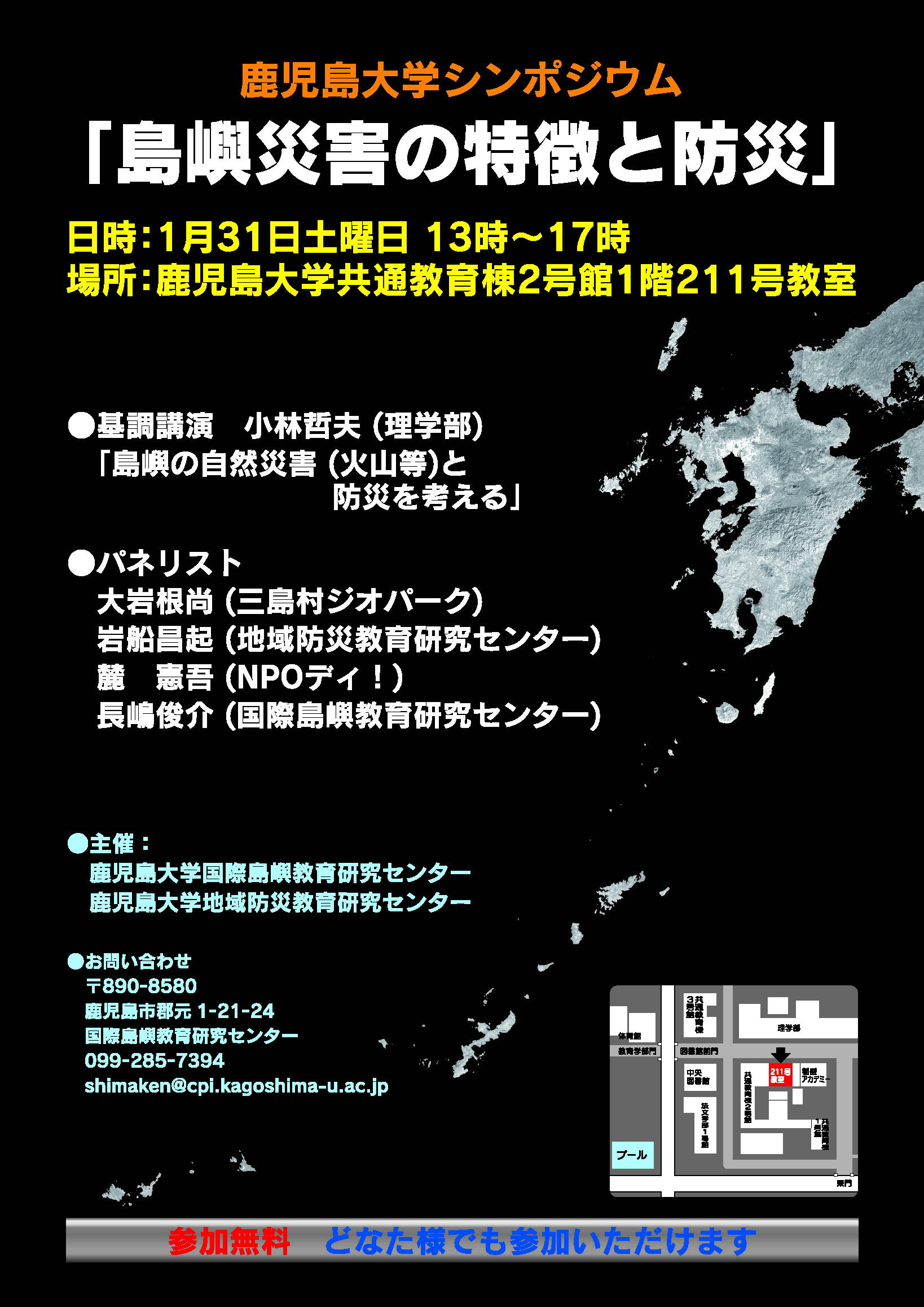Characteristics and Prevention of Disasters on Islands
|
Date:31 January 2015, 13:00 - 17:00
Place:Kagoshima University |
●Aim
The Kagoshima Prefecture is one of Japan’s most prominent prefectures
consisting of numerous islands where many disasters strike. The islands
stretch 600km from north to south and the combined areas of the remote
islands surpass that of the Okinawa Prefecture. The typhoons that land
are highly intense and their impact and amount of damage caused can be
very serious. The islands also suffer many volcanic disasters, which are
internationally renowned. Each island has its own unique disaster propensities,
characteristics, and apprehensions of the damages from tsunami, nuclear
power generation, landslides and floods caused by heavy rain and so on.
This can be seen through disaster drills and disaster recovery measures.
There are many problems around island disaster prevention coming from the
various islands’ specific circumstances. Beyond the routine preventative
measures, how do we prepare and how do we ensure we take all possible measures
for disaster prevention? In this symposium we aim to discuss these issues
academically and by taking into account the experiences and perspectives
of the islanders.
We hope for proactive participation from the attendees of this symposium.
●Program
13:00 Opening
13:05 Keynote speech
「Volcanic Hazards and Disaster Prevention in Remote Islands」
●KOBAYASHI Tetsuo
(Graduate School of Natural Science and Technology, Kagoshima
University)
- There are several active volcanoes in the Nansei-shoto islands to the
south of Kagoshima, such as Satsuma-Iojima, Kuchinoerabujima, Kuchinoshima,
Nakanoshima, Suwanosejima, Yokoatejima, and Io-Torishima.
At this lecture I will refer to two examples concerning disaster prevention
in a volcanic island, such as the Sakurajima and the Suwanosejima volcanoes
which produced large scale eruptions in historical times.
14:00 Report 1
「The Role of Community FM at the Time of Disaster」
●FUMOTO Kengo (NPO Amami FM D!)
- Amami FM started in 2007 and was the first radio station established
in a remote island in the Kyusyu area.
It is known familiarly as the radio of “Shimatcyu; which means local
islander”, by the “Siamatcyu”, for the “Simatcyu”. It helps islanders to
search for their identity by providing information and news about the island.
The 24 hours for five days narrowcasting for torrential rains that occurred
in Amami city in 2010 provided critical information which mass-media couldn’t
cover.
I would like to report how the communications with listeners through
the radio can play an important role in reducing damages in emergency situations.
14:20 Report 2
「Tsunami Disaster Prevention According to the Nature of Islands:
A Model of the Evacuation Plan in the Amami Islands」
●IWAFUNE Masaki
(Research and Education Center for Natural Hazards, Kagoshima
University)
- Tsunami waves inundate a settlement on alluvial plan with an altitude
of several meters above sea level easier than one on marine terrace with
an altitude of tens meters above sea level. The Amami Oshima Island is
one of the "high islands" with mountainous and hilly districts
that enclose most residential areas in alluvial plains along the coast.
In view of 1) the high naturalness of the mountainous districts with habitats
of "endangered animals" such as the Amami rabbit (Pentalagus furnessi), 2) the difficult entrance into the mountainous districts because of the presence of Habu, a venomous and dangerous snake (Protobothrops), 3) the great worth of the nature and landscape as tourist attractions,
and 4) the high rate of elderly persons needing assistance for evacuation,
the people in the Amami Oshima island should take comprehensive measures
against tsunami disasters. Rather than the construction of seawalls along
the coast, these measures should include an evacuation plan by vehicles
from the rural settlements to roads in the mountainous districts.
14:40 Report 3
「Volcanic Benefits and Disaster Prevention in the Iwojima Islands
and the Mishimamura Village」
●OIWANE Hisashi (Local government of Mishimamura Village)
- The Satsuma-Iwojima Island is a volcanic island located at the Northwestern
edge of the Kikai Caldera. The eastern part of the island features Iwo-dake
volcano, which shows fumarolic and hydrothermal activities. These activities
have been benefiting local people, supplying natural sulphur ores and hot
springs for thousands of years. At present, only 113 people are living
in the island. Recently, we started to use these natural resources for
diverse purposes, for example, for making fireworks using natural sulphur
and for kayaking on the hydrothermal area. On the other hand, the Iwo-dake
Volcano had a small eruption in 2013, which reminds us to pay attention
to volcanic activity. Hence we have an annual emergency evacuation training
that all islanders participate in. In this talk, I will introduce examples
of our efforts to take advantage of the volcano and our emergency evacuation
training procedures.
15:00 Report 4
「Characteristics and Diversity of Natural Disasters on Islands and
Local Society」
●NAGASHIMA Shunsuke
(Research Center for the Pacific Islands, Kagoshima University)
- There tends to be distinctiveness in the way natural disasters strike
in areas with strong island characteristics. Islands are affected in diverse
ways depending on factors such as remoteness, size, altitude, nature of
the surrounding seas and these factors affect also disaster forecast, rescue
procedures, alarm and evacuation methods, the severity of the disaster
and the duration of its effects. The safety, reassurance, and stability
of life on the island is based on the ability to maintain rescue and recovery
services continuously. The unity among the island people, as well as their
wisdom and ability to endure and overcome hardships have framed the island
culture, technology and societal rules. There are countless examples showing
how disasters have forced people to come together, such as group migration.
What are the current and future options for effective responses to problems
such as global warming, extreme weather and human-made calamity? In this
presentation, the history of various risks that were overcome since the
“Water and Light Revolution” will be summarized. We will also examine the
comprehensive and functional disaster management governance and disaster
prevention systems that support the islanders.
15:30 Discussion
17:00 Closing

(Poster jepg) |